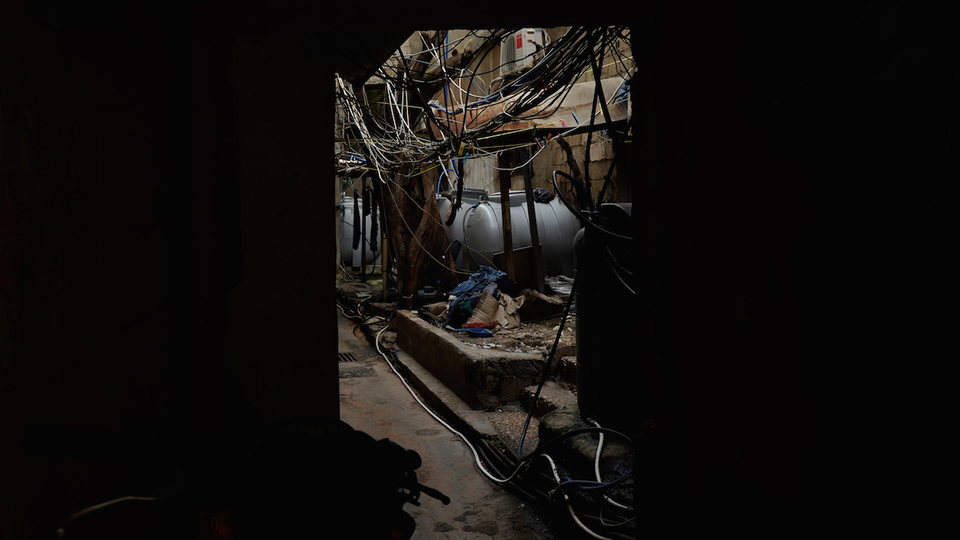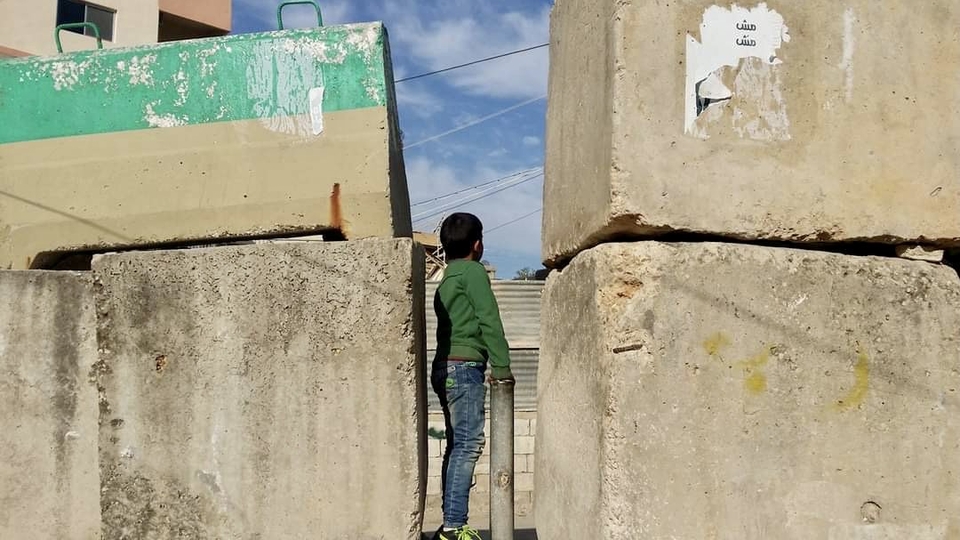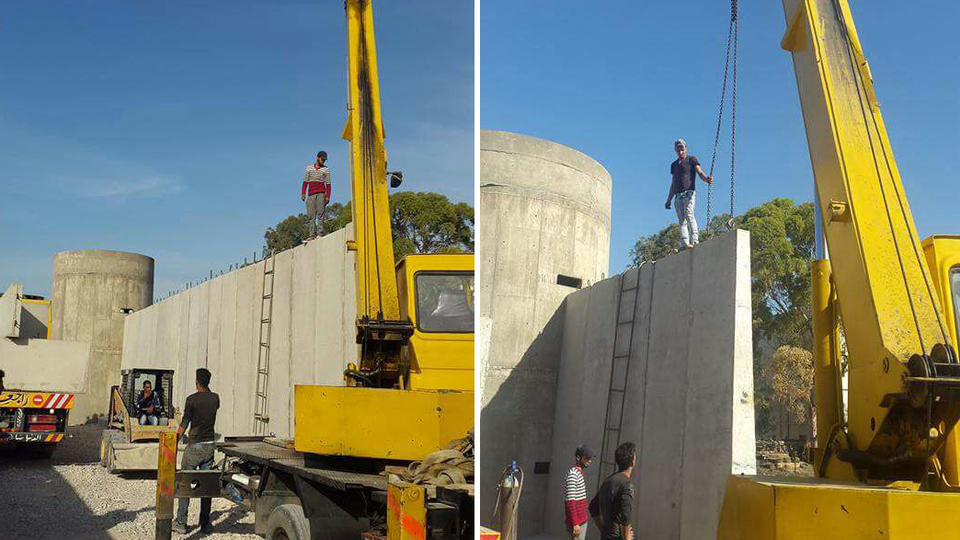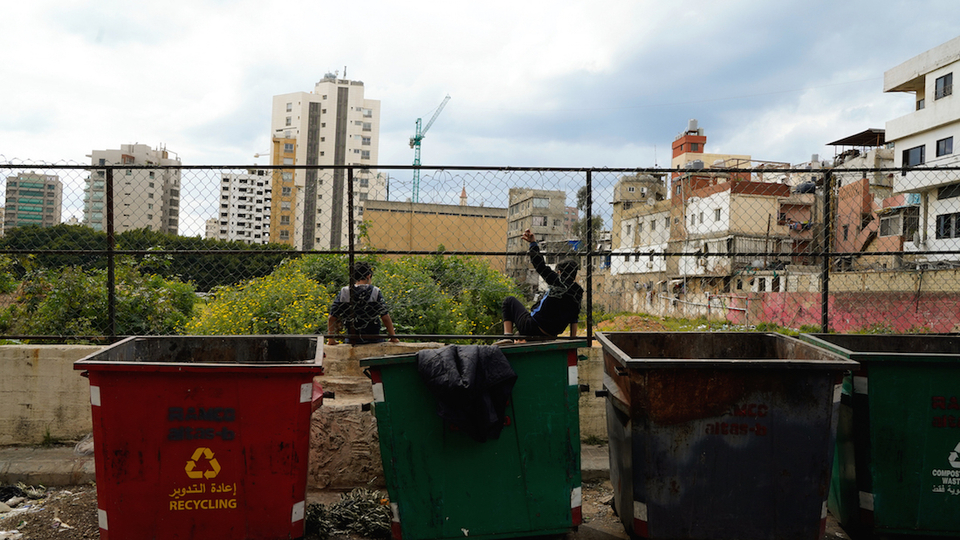Palestinian Camps in Lebanon: Reflecting on Patterns of Marginalization, Isolation and Control
The outbreak of the novel coronavirus pandemic was still in its early stages with no registered cases inside the formal and informal Palestinian camps in Lebanon when, on March 13, 2020, Lebanese Forces (LF) party leader Samir Geagea spoke of the necessary measures that should be taken to stem the spread of the virus. Geagea suggested closing both the Palestinian camps and unofficial Syrian camps, banning entry to and exit from these areas for any reason while still providing the residents with their basic needs. The statement of the LF leader was discriminatory and inseparable from a history of crimes committed by the Lebanese Forces militia against Palestinian men and women during the civil war.
Geagea’s call, however, was in line with the systematic policies aimed at controlling the domain of the Palestinian camps that has intensified since the end of the war. These policies are based on spatial marginalization and isolation through urban, social, and economic neglect, but also through brute securitization against the camps’ inhabitants, perpetually subjecting them to the harshest and most violent repercussions of various crises.
Absent urban planning, deteriorating infrastructure, and shrinking public domain and possibilities for co-operative work are policies that transform the camp into a place that expels some of its inhabitants while suffocating the majority that cannot afford to leave.
Absent urban planning, deteriorating infrastructure, and shrinking public domain and possibilities for co-operative work are policies that transform the camp into a place that expels some of its inhabitants while suffocating the majority that cannot afford to leave. These policies structure life in the camps, the ways in which their residents interact with their surroundings, their economic conditions, and political practices.
The following is an attempt to understand three patterns of spatial marginalization since the camps’ establishment, and especially after the civil war, to chart their effects and potential repercussions amid the spread of COVID-19, the country's financial collapse, and the rise in poverty and unemployment.
A Historical Glance
Today, there are 12 officially recognized Palestinian camps, as opposed to 15 after the Nakba. In 1974, the Israelis destroyed the Nabatiyeh camp, from which the Palestinian resistance launched guerilla operations, given its proximity to the border with occupied Palestine. In 1976, Lebanese right-wing militias, backed by the Syrian army, destroyed the two camps of Tal al-Zaatar and Jisr al-Basha which were located within their strongholds.
Palestinian camps in Lebanon are built on land that was leased for 99 years and made available to Palestinians to live in by the United Nations Relief and Work Agency for Palestine Refugees (UNRWA) after the Nakba of 1948. Over the years, other migrants and refugees joined them.
In 1969, as the Palestinian Liberation Organization (PLO) was growing stronger in Lebanon, the Cairo Agreement was signed between the PLO and the Lebanese army. After years of control and repression by the Deuxième Bureau of the army intelligence, the agreement transferred the administration of the camps to the PLO. The consequences of this agreement persist, nearly forty years since the PLO’s fighters were forced out of Lebanon although the Lebanese parliament at the time withdrew from the agreement in 1987 without notifying the organization. To this day, the camps’ internal management is still delegated, in form, to the Palestinians, and neither the Lebanese security forces nor the Lebanese army are physically present inside the camps. The situation is only different in the Nahr al-Bared camp, where Lebanese security forces have been deployed since the camp's destruction in 2007 during battles between the army and militants, and the Mieh Mieh camp, from which militants were disarmed after the 2019 clashes.
On the one hand, many Palestinians hold on to the status quo inside the camps because they mistrust their surroundings given painful past experiences, namely the horrific crimes committed against them at the hands of right-wing militias and the siege imposed by the Amal movement during the War of the Camps (1985-1988). For the Palestinian factions and forces active inside the camps, the current arrangement is maintained because it gives them the authority to partake in managing the camps’ economy that is mostly based on international aid. Since the PLO’s withdrawal from Lebanon and its complete abandonment of the camps, international aid has become one of the pillars of this economy, in addition to UNRWA’s assistance, as well as limited commercial activity. Many residents are only able to earn an income through temporary, seasonal or informal work.
After years of control and repression by the army intelligence, the 1969 Cairo Agreement transferred the administration of the camps to the Palestinian Liberation Organization.On the other hand, this status quo absolves the Lebanese state of any responsibility towards the camps and their residents, especially as it relates to providing services and ensuring socio-economic and other rights. The Lebanese state’s role remains limited to managing the camp’s perimeters through the army, on the outside, and to controlling its administration on the inside through the army intelligence.
This strategy serves to contain the same geographic space, regardless of population growth, and to maintain a state of isolation and control over this space. Engaging with the camps almost exclusively through the lens of security has transformed them over the years into impoverished slums with dilapidated infrastructure. Slums that the state can besiege and control through Palestinian forces or individuals from within, which further deteriorates living conditions in the camps. This crisis is also exacerbated by a legalized form of discrimination that, for instance, bars Palestinians from owning real estate. Denying Palestinians the right to own property leads to their confinement to an ever-shrinking plot of land that has mostly remained unchanged since the camps’ establishment in the wake of the Nakba. At the time, the camps were ostensibly temporary until the return of refugees to Palestine. Today, however, they have become quasi-permanent.

A black background with a rectangular frame showing a network of electrical wires at street level in one of the narrow streets of Mar Elias camp. Mar Elias camp, like all Palestinian camps in Lebanon, suffers from dilapidated infrastructure. Mar Elias camp, Beirut. April 11, 2021. (Mohamad Cheblak/The Public Source)
Such policies, laws, and regulations are indeed violent and widen the disparities between the residents of the camps and those living in their surroundings. They impede opportunities for solidarity and joint political action between the working class and oppressed groups on either side of the fence, just as they hinder economic activity and development. In this context, it is worth noting that the Nahr al-Bared camp served as an example of what a Palestinian camp in Lebanon could look like, as it encompassed a relatively decent urban setting that preserved some characteristics of the Palestinian village. In addition, its vibrant economic activity and openness to its surroundings led to the emergence of a middle class and some stability. Unfortunately, it all came to an abrupt end when war broke out between the Lebanese army and Fatah al-Islam in 2007. A stifling blockade during the battles dealt a heavy blow to the camp's commercial activity which completely ceased after the camp's destruction and looting.
Urban maps issued by the General Directorate of Urban Planning represent Palestinian camps as empty parcels of land, according to urban researcher Abir Saksouk-Sasso. She explains that this applies to mapping charts from 1991 and 2002, and not only to those that were issued during the first years of asylum. In those years, she elaborates, it made sense to consider the camps temporary based on the belief that refugees would soon return home. But this persistent representation raises suspicions that the state is waiting for an opportunity to remove the camps in one way or another.
Urban maps issued by the General Directorate of Urban Planning represent Palestinian camps as empty parcels of land, according to urban researcher Abir Saksouk-Sasso, and this persistent representation raises suspicions that the state is waiting for an opportunity to remove the camps in one way or another.
This could explain the systematic destruction of the Nahr al-Bared camp by the Lebanese army during the 2007 war which demolished 95 percent of the original camp buildings and part of the urban sprawl outside the original camp. The reconstruction of the camp would have been impossible had it not been for pressure from Lebanese and Palestinian associations, institutions, and various bodies, as well as the formation of a local committee to oversee the reconstruction process. The committee comprised engineers, architects and researchers in urban planning who endeavored to document, map and assess the degree of destruction. At a later stage, committee members also lobbied efforts to involve former camp residents in the reconstruction planning and managed to steer the process in a completely different direction than the one initially proposed by the state.
Over the years, the Lebanese state developed various methods and practices to marginalize and control the camps under the pretext that their inhabitants pose a security threat. These practices can be categorized into three paradigms.
Pattern 1: Informal Urbanization and Dilapidated Infrastructure
The first paradigm involves neglecting the camps. This neglect is all-encompassing and includes turning a blind eye to infrastructural decay and failing to provide basic services under the pretext that camps are not the responsibility of the state. This is the case in Beirut’s three camps (Mar Elias, Shatila and Burj al-Barajneh), al-Jalil in Baalbek, Beddawi in Tripoli, Mieh Mieh in Saida, and the camp in Dbayeh, north of Beirut.
While the number of residents in the Mar Elias refugee camp grew from a few hundred upon its establishment in 1952 to nearly 1,800 today, the residential area remains unchanged and stands at just 0.2 sq km.
There are stark differences between refugee camps and surrounding neighborhoods; they are hyper visible and immediately experienced. Let's examine the Mar Elias camp that is adjacent to Ramlet al-Bayda. On foot, entering the camp means trading a wide boulevard for a narrow street then narrower alleywayss; it means exchanging some form of urban planning for disorganized, run-down, and makeshift infrastructure. And while the number of residents in the camp grew from a few hundred upon its establishment in 1952 to nearly 1,800 today, the residential area remains unchanged and stands at just 0.2 sq km. In this densely populated camp, there are also no public spaces for leisure or recreational activities. Moreover, the owners of the adjoining land — which used to be a football field and an outlet for the camp’s residents, notably its youth — put up fences to keep the camp’s residents out. Here, we have de facto marginalization in a UNRWA-rented geographical area that the state neither intervenes in through urban planning, nor contributes towards the improvement of its infrastructure and the provision of service. This is the situation in every camp identified within this first pattern. And the Shatila camp fares even worst, given its failing infrastructure, particularly its sewage system, which causes wastewater to flood its streets from time to time.
Pattern 2: Spatial Isolation and Movement Control
What exists in the first pattern continues here in addition to designating entrances to and exits from the camps. The Lebanese army set up round-the-clock checkpoints to monitor the movement of residents, occasionally performing identity checks. Concrete fences along the perimeters were also added to prevent cars and motorcycles from circumventing checkpoints. The measures of control in this pattern apply to the three camps of Tyre (al-Rashidieh, al-Bass, and Burj el-Shemali), which are close to the border with occupied Palestine and are intended to prevent armed resistance against Israel. This pattern also applies to the Nahr al-Bared camp in the aftermath of the 2007 war.
You could enter Burj al-Shemali camp, in which I lived for several years, in one of two ways: crossing by car, on foot, or on a motorbike through a Lebanese army checkpoint, or by slipping through narrow openings in the concrete fence which prevents the entry of anything larger than a human body (with the implementation of a nationwide lockdown, the army sealed these interstices to re-route and make entry possible only through its checkpoints).
Army checkpoints and concrete fences further isolate the camp from its surroundings and tighten external control over the residents' lives.
In Burj el-Shemali, we identify the same urban neglect, poor infrastructure, and lack of public spaces we find across the camps in the first pattern. The army checkpoints and the concrete fence, however, further isolate the camp from its surroundings and tighten external control over the residents' lives. These are the everyday realities instituted through identity checks, control of goods entering the camp, and the occasional blocking of building materials based on arbitrary military decisions aimed at preventing more construction inside the camp (even though Palestinians are not allowed to own property).
When these types of restrictions are applied, building material is smuggled in through the fence, which inevitably leads to an increase in their price. The smuggling, however, becomes impossible when soldiers are stationed near the narrow openings.

A child stands in a narrow opening between concrete blocks. The Lebanese army limits the passage of cars into a number of Palestinian camps through checkpoints and closes other entrances with concrete walls, leaving only pedestrian pathways. Burj al-Shemali camp, Tyre. January 21, 2017. (Nadia Ahmad/The Public Source)
Pattern 3: Complete Isolation and Surveillance from Above
This is by far the harshest pattern. Here, there is total enclosure through a separation wall — with watchtowers — as Lebanese army checkpoints impose severe restrictions on movement. This third pattern applies to the Ain el-Helweh camp in Saida, the largest and most densely populated refugee camp. The material separation of the camp from its surroundings is total. The wall, the construction of which is nearly finished, ate at some of the open space available to residents and that included agricultural orchards which now lie behind the wall. It also made entering and exiting the camp possible only through the four Lebanese army checkpoints which enforced strict measures. For a brief period of time, in 2018, the Lebanese army even set up electronic gates.
One cannot think of Ain el-Helweh and the modes of isolating it without being reminded of the Israeli apartheid wall in the West Bank, which separates colonizers from colonized and settlers from indigenous inhabitants.
One cannot think of Ain el-Helweh and the modes of isolating it without being reminded of the Israeli apartheid wall in the West Bank, which separates colonizers from colonized and settlers from indigenous inhabitants. The Lebanese state, largely assisted by the mainstream media, tries to present Ain el-Helweh as a source of terror and as an imminent security threat. In a brief statement, the army had stated that it was building a wall aimed at “preserving the camp’s safety and preventing terrorists from infiltrating or exiting the camp.” But, the reality on the ground is that these measures have only caused the camp's infrastructure to go from bad to worse. Its residents, surrounded by a wall, have become prisoners surveilled through watchtowers at all times. They cannot go to work and back home without seeking permission. They need someone's permission to simply live their lives.
This is a camp in which somewhere between 21,000 and 47,000 people live in an area that does not exceed 3 sq km. They have to endure harsh restrictions under the pretext that there are wanted terrorists dwelling among them. Large amounts of money from the treasury of an economically collapsed state are spent on securitizing this camp, instead of finding better and more feasible solutions, or returning to proven paradigms, such as Nahr al-Bared before 2007. Had this model been applied to other camps, alongside fair amendments to labor and ownership laws, among others, the situation would have significantly improved and the permanent tension would have eased.
This is especially relevant when Israel, whose establishment forced the creation of these camps in the first place, continues to shirk any responsibility for the dispossession of Palestinians in Lebanon and elsewhere. Needless to say, holding the Israeli state to account and demanding compensation does not undermine the Palestinian people's inalienable right to return to our homes and homeland.

In 2016, the building of a concrete wall around the Ain el-Helweh camp began under the supervision of the Lebanese army. With the construction reaching its final stages today, entries and exits from the camp happen exclusively through army checkpoints. Ain el-Hilweh camp, Saida. November 19, 2016. (Al-Modon)
Joint Responsibility
The Lebanese state does not solely bear the responsibility for the situation that has befallen the Palestinian camps today. Besides Israel, which is responsible first and foremost for the Palestinian refugee crisis, the United Nations also bears its share of the blame.
Israel has managed to pass the buck for the refugee issue to the UN, which in turn ended up establishing a special body for them: UNRWA. The latter’s aid and ability to employ and find work for Palestinians (one of its main tasks) have declined. Furthermore, UNRWA’s educational and health services have also dramatically declined in recent years due to mismanagement, corruption, and dwindling funding.
The Lebanese state does not solely bear the responsibility for the situation that has befallen the Palestinian camps today. Besides Israel, which is responsible first and foremost for the Palestinian refugee crisis, the United Nations also bears its share of the blame.
There is also the PLO, which was once the only legitimate representative of all Palestinians. Since the signing of the Oslo Accords in 1993, however, and the formation of the Palestinian Authority, the organization has largely relinquished its responsibility toward the refugees, something that is reflected in the decline of its financial contributions. The PLO’s contributions have become reduced to nothing but a token sum that does not even meet the most basic needs of its recipients, as evident by the dire situation inside the camps. It is also deplorable to see the current state of the PLO-affiliated Palestinian Red Crescent Society (PRCS), which Palestinians and some Lebanese living in the vicinity of the camps once relied on for quality treatment through the organization’s offices in Lebanon.
Today, most PRCS centers have greatly deteriorated. A situation that is compounded by a lack of equipment and cadres, making them the last resort for camp residents when they are sick or injured. This evasion of responsibility by those in power greatly imperils the lives of the camps’ residents in particular, and Palestinians in Lebanon in general, in the midst of Lebanon's ongoing economic crisis, the depreciation of the Lebanese lira, and a deadly virus that spreads faster in more densely populated areas with run-down infrastructure. During the total lockdowns imposed by the caretaker government, all movement from and to the camps was largely halted as increasing marginalization and isolation measures were imposed. This caused workers in the informal economy, who constitute the majority of the camps’ workforce, to lose their income as unemployment and poverty rates reached nearly 90 percent.
Amid these deplorable conditions, the camps’ residents are left with two choices, either to rise up again, or to continue to emigrate from Lebanon once the world opens up again.
